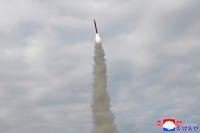NATIONAL HARBOR, Md. -- General Dynamics Mission Systems' "Knifefish" unmanned undersea vehicle (UUV), or underwater drone, has been designed to serve as a roving, mine-detecting scout for Littoral Combat Ships.
A model of the 21-foot Knifefish was on display at the opening of the Sea-Air-Space 2018 exposition Monday at the Gaylord National Convention Center at National Harbor, Maryland. Last October, Knifefish successfully completed sea trials testing its ability to detect mines at various depths.
Knifefish was built to provide LCS commanders with an off-board sensor to detect, classify and identify mines in "high clutter" sea environments and relay the data back to the mother ship, which can then destroy any threats.
"The system demonstrated its ability to reliably find mines in different environments," Capt. Jonathan Rucker, Knifefish program manager, said in a statement at the time. "Knifefish provides the Navy a critical means to find and identify bottom, buried, and volume mines, providing a much-needed capability for the warfighter."
Although initially planned for the Navy's Littoral Combat Ship, the Knifefish can operate from any surface ship, according to Rucker.
The Knifefish UUV was developed from technology designed for General Dynamics' Bluefin Robotics Bluefin-21 deep-water Autonomous Undersea Vehicle (AUV). The Bluefin-21 was in the headlines in 2014 in the unsuccessful search to find missing Malaysia Airlines Flight 370.
-- Richard Sisk can be reached at Richard.Sisk@Military.com.












